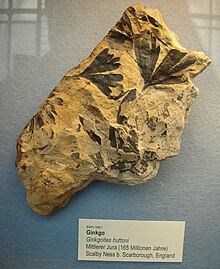
KNOWPIA
WELCOME TO KNOWPIA
Summary
Ginkgoites is a genus of extinct plants belonging to Ginkgoaceae. Fossils of these plants have been found around the globe during the Triassic, Jurassic, Cretaceous, with fossils also known from the Paleogene. The name was created as a form genus in 1919 by Albert Seward, who stated: "I ... propose to employ the name Ginkgoites for leaves that it is believed belong either to plants generically identical with Ginkgo or to very closely allied types".[2]
| Ginkgoites | |
|---|---|

| |
| fossil leaves identified as Gingkoites | |
| Scientific classification | |
| Kingdom: | Plantae |
| Clade: | Tracheophytes |
| Clade: | Gymnospermae |
| Division: | Ginkgophyta |
| Class: | Ginkgoopsida |
| Order: | Ginkgoales |
| Family: | Ginkgoaceae |
| Genus: | †Ginkgoites Seward, 1919 emend. Watson et al., 1999 |
| Type species | |
| Ginkgoites sibirica[1] (Heer) Seward, 1919
| |
| Other species | |
| |
References edit
- ^ Villar De Seoane, L.; Cúneo, N. R.; Escapa, I.; Wilf, P.; Gandolfo, M. A. (2015). "Ginkgoites patagonica (Berry) comb. nov. from the Eocene of Patagonia, Last Ginkgoalean Record in South America". International Journal of Plant Sciences. 176 (4): 346–263. doi:10.1086/680221. hdl:11336/26298. S2CID 14982181.
- ^ Albert Charles Seward (1919), Fossil plants: for students of botany and geology, vol. 4, Cambridge University Press, p. 10, doi:10.5962/bhl.title.54901


